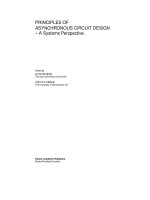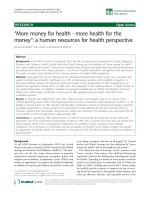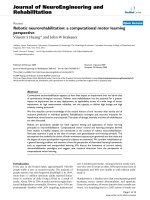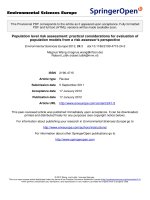ENGINEERING PROBLEM SOLVING: A CLASSICAL PERSPECTIVE pdf
Bạn đang xem bản rút gọn của tài liệu. Xem và tải ngay bản đầy đủ của tài liệu tại đây (4.45 MB, 481 trang )
ENGINEERING PROBLEM SOLVING:
A CLASSICAL PERSPECTIVE
by
Milton C. Shaw
Arizona State University
Tempe, Arizona
NOYES PUBLICATIONS
WILLIAM ANDREW PUBLISHING
Norwich, New York, U.S.A.
Copyright © 2001 by Noyes Publications
No part of this book may be reproduced or
utilized in any form or by any means, elec-
tronic or mechanical, including photocopying,
recording or by any information storage and
retrieval system, without permission in writing
from the Publisher.
Library of Congress Catalog Card Number: 00-022003
ISBN: 0-8155-1447-6
Printed in the United States
Published in the United States of America by
Noyes Publications / William Andrew Publishing
Norwich, New York, U.S.A.
www.williamandrew.com
www.knovel.com
10 9 8 7 6 5 4 3 2 1
Library of Congress Cataloging-in-Publication Data
Shaw, Milton Clayton, 1915-
Analytical engineering: a classical perspective / Milton C. Shaw.
p. cm.
Includes bibliographical references and index.
ISBN 0-8155-1447-6
1. Engineering mathematics. 2. Engineering History. I. Title.
TA330 .S47 2001
620'.001'51 dc21 00-022003
CIP
v
MATERIALS SCIENCE AND PROCESS TECHNOLOGY SERIES
Series Editors
Gary E. McGuire, Microelectronics Center of North Carolina
Stephen M. Rossnagel, IBM Thomas J. Watson Research Center
Rointan F. Bunshah, University of California, Los Angeles (1927–1999), founding editor
Electronic Materials and Process Technology
CHARACTERIZATION OF SEMICONDUCTOR MATERIALS, Volume 1: edited by Gary E.
McGuire
CHEMICAL VAPOR DEPOSITION FOR MICROELECTRONICS: by Arthur Sherman
CHEMICAL VAPOR DEPOSITION OF TUNGSTEN AND TUNGSTEN SILICIDES: by John E.
J. Schmitz
CHEMISTRY OF SUPERCONDUCTOR MATERIALS: edited by Terrell A. Vanderah
CONTACTS TO SEMICONDUCTORS: edited by Leonard J. Brillson
DIAMOND CHEMICAL VAPOR DEPOSITION: by Huimin Liu and David S. Dandy
DIAMOND FILMS AND COATINGS: edited by Robert F. Davis
DIFFUSION PHENOMENA IN THIN FILMS AND MICROELECTRONIC MATERIALS: edited by
Devendra Gupta and Paul S. Ho
ELECTROCHEMISTRY OF SEMICONDUCTORS AND ELECTRONICS: edited by John
McHardy and Frank Ludwig
ELECTRODEPOSITION: by Jack W. Dini
HANDBOOK OF CARBON, GRAPHITE, DIAMONDS AND FULLERENES: by Hugh O.
Pierson
HANDBOOK OF CHEMICAL VAPOR DEPOSITION, Second Edition: by Hugh O. Pierson
HANDBOOK OF COMPOUND SEMICONDUCTORS: edited by Paul H. Holloway and Gary
E. McGuire
HANDBOOK OF CONTAMINATION CONTROL IN MICROELECTRONICS: edited by Donald
L. Tolliver
HANDBOOK OF DEPOSITION TECHNOLOGIES FOR FILMS AND COATINGS, Second
Edition: edited by Rointan F. Bunshah
HANDBOOK OF HARD COATINGS: edited by Rointan F. Bunshah
HANDBOOK OF ION BEAM PROCESSING TECHNOLOGY: edited by Jerome J. Cuomo,
Stephen M. Rossnagel, and Harold R. Kaufman
HANDBOOK OF MAGNETO-OPTICAL DATA RECORDING: edited by Terry McDaniel and
Randall H. Victora
HANDBOOK OF MULTILEVEL METALLIZATION FOR INTEGRATED CIRCUITS: edited by
Syd R. Wilson, Clarence J. Tracy, and John L. Freeman, Jr.
HANDBOOK OF PLASMA PROCESSING TECHNOLOGY: edited by Stephen M. Rossnagel,
Jerome J. Cuomo, and William D. Westwood
HANDBOOK OF POLYMER COATINGS FOR ELECTRONICS, Second Edition: by James
Licari and Laura A. Hughes
HANDBOOK OF REFRACTORY CARBIDES AND NITRIDES: by Hugh O. Pierson
HANDBOOK OF SEMICONDUCTOR SILICON TECHNOLOGY: edited by William C. O’Mara,
Robert B. Herring, and Lee P. Hunt
vi Series
HANDBOOK OF SEMICONDUCTOR WAFER CLEANING TECHNOLOGY: edited by Werner
Kern
HANDBOOK OF SPUTTER DEPOSITION TECHNOLOGY: by Kiyotaka Wasa and Shigeru
Hayakawa
HANDBOOK OF THIN FILM DEPOSITION PROCESSES AND TECHNIQUES: edited by Klaus
K. Schuegraf
HANDBOOK OF VACUUM ARC SCIENCE AND TECHNOLOGY: edited by Raymond L.
Boxman, Philip J. Martin, and David M. Sanders
HANDBOOK OF VLSI MICROLITHOGRAPHY: edited by William B. Glendinning and John
N. Helbert
HIGH DENSITY PLASMA SOURCES: edited by Oleg A. Popov
HYBRID MICROCIRCUIT TECHNOLOGY HANDBOOK, Second Edition: by James J. Licari
and Leonard R. Enlow
IONIZED-CLUSTER BEAM DEPOSITION AND EPITAXY: by Toshinori Takagi
MOLECULAR BEAM EPITAXY: edited by Robin F. C. Farrow
SEMICONDUCTOR MATERIALS AND PROCESS TECHNOLOGY HANDBOOK: edited by
Gary E. McGuire
ULTRA-FINE PARTICLES: edited by Chikara Hayashi, R. Ueda and A. Tasaki
WIDE BANDGAP SEMICONDUCTORS: edited by Stephen J. Pearton
Ceramic and Other Materials—Processing and Technology
ADVANCED CERAMIC PROCESSING AND TECHNOLOGY, Volume 1: edited by Jon G. P.
Binner
CEMENTED TUNGSTEN CARBIDES: by Gopal S. Upadhyaya
CERAMIC CUTTING TOOLS: edited by E. Dow Whitney
CERAMIC FILMS AND COATINGS: edited by John B. Wachtman and Richard A. Haber
CORROSION OF GLASS, CERAMICS AND CERAMIC SUPERCONDUCTORS: edited by
David E. Clark and Bruce K. Zoitos
FIBER REINFORCED CERAMIC COMPOSITES: edited by K. S. Mazdiyasni
FRICTION AND WEAR TRANSITIONS OF MATERIALS: by Peter J. Blau
HANDBOOK OF CERAMIC GRINDING AND POLISHING: edited by Ioan D. Marinescu, Hans
K. Tonshoff, and Ichiro Inasaki
HANDBOOK OF HYDROTHERMAL TECHNOLOGY: edited by K. Byrappa and Masahiro
Yoshimura
HANDBOOK OF INDUSTRIAL REFRACTORIES TECHNOLOGY: by Stephen C. Carniglia
and Gordon L. Barna
SHOCK WAVES FOR INDUSTRIAL APPLICATIONS: edited by Lawrence E. Murr
SOL-GEL TECHNOLOGY FOR THIN FILMS, FIBERS, PREFORMS, ELECTRONICS AND
SPECIALTY SHAPES: edited by Lisa C. Klein
SOL-GEL SILICA: by Larry L. Hench
SPECIAL MELTING AND PROCESSING TECHNOLOGIES: edited by G. K. Bhat
SUPERCRITICAL FLUID CLEANING: edited by John McHardy and Samuel P. Sawan
NOTICE
To the best of our knowledge the information in this publication is
accurate; however the Publisher does not assume any responsibility
or liability for the accuracy or completeness of, or consequences
arising from, such information. This book is intended for informational
purposes only. Mention of trade names or commercial products does
not constitute endorsement or recommendation for use by the Publisher.
Final determination of the suitability of any information or product
for use contemplated by any user, and the manner of that use, is the
sole responsibility of the user. We recommend that anyone intending
to rely on any recommendation of materials or procedures mentioned
in this publication should satisfy himself as to such suitability, and
that he can meet all applicable safety and health standards.
Dedicated to my wife,
Mary Jane
Table of Contents xiii
xiii
1 What Engineers Do 1
1.0 INTRODUCTION 1
2.0 ENGINEERING EDUCATION 3
3.0 OBJECTIVE AND PROCEDURE 6
4.0 GALILEO 6
2 Rigid Body Mechanics 11
1.0 HISTORICAL INTRODUCTION 11
2.0 STATICS 13
3.0 TRUSSES 16
4.0 FRICTION 19
5.0 GALILEO REGARDING ROPE 22
6.0 KINEMATICS 24
6.1 Projectiles 24
6.2 Crank Mechanism 26
6.3 Pulleys 30
7.0 KINETICS 31
8.0 VIBRATION 31
9.0 SUMMARY 33
PROBLEMS 33
Contents
xiv Engineering Problem Solving: A Classical Perspective
3 Dimensional Analysis 41
1.0 INTRODUCTION 41
2.0 DEFINITIONS 42
3.0 FUNDAMENTAL QUANTITIES 44
4.0 PROCEDURE 44
5.0 CHANGE OF UNITS 47
6.0 GALILEO REGARDING MOTION OF A PROJECTILE 48
7.0 SIMPLE PENDULUM 50
PROBLEMS 52
4 Deformable Body Mechanics 59
1.0 INTRODUCTION 59
2.0 STRESS AND STRAIN 60
3.0 BEAM STRENGTH 64
4.0 GALILEO REGARDING BEAM STRENGTH 68
5.0 STRENGTH-TO-WEIGHT RATIO 73
6.0 BEAM DEFLECTION 76
7.0 COLUMNS 78
8.0 IMPACT 80
9.0 COMPOSITE BEAMS 82
10.0 VIBRATIONS 83
PROBLEMS 87
5 Fluid Mechanics 93
1.0 INTRODUCTION 93
2.0 FLUID PROPERTIES 93
3.0 FLUID STATICS 97
4.0 SURFACE TENSION 99
5.0 PIPE FLOW 101
6.0 HYDRODYNAMIC LUBRICATION 106
7.0 BERNOULLI EQUATION 110
8.0 GALILEO 112
9.0 CAPILLARY FLOW 114
PROBLEMS 115
Table of Contents xv
6 Aerodynamics: The Boundary Layer and
Flow Separation 125
1.0 INTRODUCTION 125
2.0 STAGNATION POINT 126
3.0 VISCOUS DRAG COMPONENT 127
4.0 FLOW SEPARATION AND PRESSURE DRAG 127
5.0 LAMINAR-TURBULENT TRANSITION IN THE
BOUNDARY LAYER 128
6.0 STREAMLINING 129
7.0 DRAG ON A SPHERE 130
8.0 PARADOXES 132
9.0 AIRFOILS 132
10.0 STALL 133
11.0 STEADY AIRPLANE PERFORMANCE 135
12.0 MAGNUS EFFECT 135
13.0 PERIODIC VORTICES 137
14.0 CONCLUDING REMARKS 139
PROBLEMS 140
7 Similitude 147
1.0 INTRODUCTION 147
2.0 EXAMPLE: HYDRODYNAMIC BEARING 148
3.0 WIND TUNNEL 150
4.0 TOWING TANK 152
5.0 SOIL BIN 153
6.0 HYDRAULIC MACHINERY 155
7.0 STRUCTURAL MODELS 158
8.0 SIMULATION 159
9.0 GALILEO REGARDING SIMULATION 159
10.0 GALILEO REGARDING MUSICAL STRINGS 160
PROBLEMS 164
8 Materials Science 177
1.0 INTRODUCTION 177
2.0 ATOMIC STRUCTURE 177
3.0 BONDING FORCES 180
4.0 MICROSCOPIC STRUCTURE 182
xvi Engineering Problem Solving: A Classical Perspective
5.0 THEORETICAL STRENGTH OF METALS 183
6.0 THE DISLOCATION 185
7.0 BEHAVIOR OF REAL MATERIALS 188
8.0 GALILEO 189
9.0 WEAR 189
10.0 SOLIDS AND LIQUIDS 191
PROBLEMS 193
9 Engineering Materials 197
1.0 INTRODUCTION 197
2.0 METALS 197
2.1 Carbon Steels 198
2.2 Alloy Steels 198
2.3 Nonferrous Alloys 201
2.4 Hardening and Softening 202
2.5 Titanium and its Alloys 203
3.0 POLYMERS 204
4.0 GLASSES AND CERAMICS 207
5.0 ROCK AND CONCRETE 209
6.0 COMPOSITES 210
7.0 MATERIALS PROCESSING 212
7.1 Introduction 212
7.2 Casting 212
7.3 Forming 214
7.4 Stock Removal Operations 217
7.5 Powder Metallurgy 219
7.6 Joining 219
PROBLEMS 220
10 Electrical Engineering 225
1.0 INTRODUCTION 225
2.0 HISTORICAL BACKGROUND 226
3.0 ELECTRICAL CHARGE, CURRENT, AND
POTENTIAL 228
4.0 SOURCES OF EMF 230
5.0 DIRECT CURRENT 232
6.0 DIRECT CURRENT CIRCUIT ANALYSIS 235
Table of Contents xvii
7.0 MAGNETISM 237
8.0 MOTORS AND GENERATORS 238
9.0 ALTERNATING CURRENT CIRCUITS 241
10.0 TRANSFORMERS 245
11.0 INSTRUMENTS AND MEASUREMENTS 247
12.0 ELECTRONICS 250
13.0 MEASUREMENT OF TIME 255
14.0 ELECTRONIC SENSORS 256
15.0 ELECTROMAGNETIC WAVES 256
16.0 GALILEO 259
PROBLEMS 261
11 Thermal Engineering 269
1.0 INTRODUCTION 269
2.0 HISTORICAL BACKGROUND 270
3.0 HEAT, WORK, AND TEMPERATURE 271
4.0 THERMODYNAMICS 274
5.0 SECOND LAW OF THERMODYNAMICS 276
6.0 THE CARNOT CYCLE 276
7.0 THE PERFECT GAS LAW 277
8.0 THERMAL TRANSFORMATION SYSTEMS 278
8.1 Steam Power Plants 278
8.2 Internal Combustion Engines 280
8.3 Dimensional Analysis 284
9.0 HEAT TRANSFER 286
9.1 Radiation Heat Transfer 286
9.2 Conductive Heat Transfer—Steady State 288
9.3 Convective Heat Transfer 289
9.4 Nonsteady State Conduction 291
9.5 Moving Heat Source 296
PROBLEMS 299
12 Engineering Design 305
1.0 INTRODUCTION 305
2.0 CREATIVITY 309
2.1 Introduction 309
2.2 Falling Paper 311
2.3 Micro-Explosive Action 318
xviii Engineering Problem Solving: A Classical Perspective
3.0 DESIGN EXAMPLES 321
3.1 Wind Power Generation 321
3.2 The Mechanical Fuse 325
3.3 Highway Crash Barrier 331
3.4 High Speed Grinding Wheel Designs 335
3.5 The Speed Wand 340
4.0 CHEMICAL ENGINEERING 342
4.1 Introduction 342
4.2 Mechanical Activation 343
4.3 Static Mixer 347
PROBLEMS 349
13 Engineering Economics 357
1.0 INTRODUCTION 357
2.0 INTEREST 359
3.0 CAPITAL 361
4.0 INFLATION 362
5.0 DEPRECIATION 362
6.0 SIMPLE COMPARISONS 363
7.0 KELVIN'S LAW 364
8.0 DIMENSIONAL ANALYSIS 367
PROBLEMS 369
14 Engineering Statistics 375
1.0 INTRODUCTION 375
2.0 STATISTICAL DISTRIBUTIONS 376
3.0 THE NORMAL DISTRIBUTION 378
4.0 PROBABILITY 381
5.0 PERMUTATIONS AND COMBINATIONS 385
6.0 NORMAL PROBABILITY DISTRIBUTION 386
7.0 BINOMIAL DISTRIBUTION 389
8.0 CONTROL CHARTS 392
9.0 OTHER DISTRIBUTIONS 396
10.0 CURVE FITTING 397
11.0 FACTORIAL DESIGN OF EXPERIMENTS 398
PROBLEMS 403
Table of Contents xix
15 Computers In Engineering 409
1.0 INTRODUCTION 409
2.0 HISTORICAL BACKGROUND 410
3.0 THE BIRTH OF NUMERICAL CONTROL (NC) 415
3.1 Japanese Contributions 418
4.0 CALCULATORS 419
5.0 THE BIRTH OF COMPUTER-AIDED DESIGN 423
6.0 THE PERSONAL COMPUTER (PC) 423
7.0 MICROELECTRONICS 427
8.0 COMPUTER SCIENCE 430
9.0 THE INTERNET 430
10.0 ELECTRONIC MAIL 432
11.0 ENGINEERING APPLICATIONS 433
12.0 THE BAR CODE STORY 437
Epilogue 439
Appendix A: A Historical Introduction to Calculus 441
1.0 DERIVATIVE CALCULUS 442
2.0 INTEGRAL CALCULUS 446
3.0 EXAMPLES INVOLVING INTEGRATION 447
Appendix B: Conversion Factors 449
Appendix C: Abbreviations 451
Answers to Problems 453
Index 467
vii
In this day and age of ever-shorter time schedules and increasing
expectations of productivity gains in every aspect of engineering activity,
creative problem solving has become prominent among the most important
skills that engineers possess. Unfortunately, in the day-to-day intensity of the
search for new engineering solutions, it is easy to lose touch with the
foundations of that creativity. This book and its companion, Dialogues
Concerning Two New Sciences, by Galileo Galilei, 1638, are intended to
provide the working engineer a visit home to the foundations of the
engineering profession. (The book Dialogues Concerning Two New
Sciences by Galileo Galilei is available as a free e-book at the web site:
www.williamandrew.com.)
Chapter 1 explains what engineers do and how those activities differ
from those of physicists, chemists, and mathematicians. Chapters 2–7 of this
book are a guided re-examination of the major topics of the main branches
of engineering and how those ideas are involved in the design of manufac-
tured products and the solution of engineering problems. In numerous areas,
this re-examination of the core topics of solid mechanics, fluid mechanics,
and aerodynamics incorporates and interprets passages from the classic
work of Galileo, providing rich examples of how new knowledge is
developed and the important role of experiment and dialog in that develop-
ment. The book bases its visit through the development of engineering
problem solving tools by considering the use of dimensional analysis where
Preface
viii Preface
the heavier-handed solution of differential equations may not be required.
The elements of dimensional analysis are presented in Ch. 3 and are
employed throughout the remainder of the book. Throughout this book, the
often-circuitous route in the development of new ideas is emphasized.
Engineering materials presently play a very important role in engineer-
ing applications and will undoubtedly play an even more important role in the
future. Therefore, Chs. 8 and 9 are devoted to this area, the first covering
some of the more general aspects and the second discussing some of the
more practical details. This is followed by concepts in electrical and thermal
engineering in Chs. 10 and 11.
Engineering Design is the centerpiece of engineering activity and
therefore considerable space is devoted to this topic in Ch. 12.
The importance of economics, statistics, and computers is discussed
in Chs. 13 through 15. Numerous examples of applications of these topics
are presented.
At the end of most chapters, a number of self-study problems are
provided. Answers to most of the problems appear at the end of the book.
While essentially no calculus is involved in the book, a very elementary
review is presented in Appendix A. Appendices B and C provide a quick
reference to conversion factors and abbreviations.
Mid-career engineers will find this book especially valuable as a
refresher for the problem solving mind set. It will serve mechanical
engineers first working with electrical or materials science concepts as a
concise primer. It will help all engineers prepare for certification exams. It
will welcome to the profession everyone who is at all interested in pursuing
engineering or in knowing more about how engineers think.
Although this is basically not a textbook, it could be used for that
purpose as a first or second year elective course for above-average students
just beginning a course of study in one of the engineering disciplines. The
book enables beginning engineering students to get the big picture before
studying each subject in detail. Later, before pursuing each subject in greater
depth, the appropriate chapter can be read with greater attention. This is a
book which students will use again and again throughout their schooling and
professional careers. An earlier version of the present book was success-
fully used by the author as a freshman elective at MIT and Carnegie-Mellon
University.
I am indebted to the many contributions and valuable discussions with
coworkers. These include: Professors C. A. Balanis, D. L. Boyer, D.
Preface ix
Kouris, R. J. McCluskey, J. Shah, W. M. Spurgeon, Dr. B. J. Zitzewitz, and
Messers D. Ream and J. Summers. However, none of this group is
associated with any errors or omissions that remain. I take full responsibility.
In undertaking a work of this magnitude, it is to be expected that some errors
and inconsistencies will be uncovered by discerning readers and I will be
grateful to be informed of these. I also wish to acknowledge contributions
of the publisher, William Andrew Publishing. My wife, Mary Jane, spent
many hours editing the text, reading proofs, and generally improving the
manuscript for which I am most grateful.
Milton C. Shaw November, 2000
Tempe, Arizona
1
1.0 INTRODUCTION
Engineering is a profession. Its members work closely with scien-
tists and apply new and old scientific effects to produce products and
services that people want. Engineers do creative work. They are skilled in
the art of inventing new ways of using the forces of nature to do useful
things. Scientists strive to understand nature while engineers aim to
produce useful products subject to economic and societal constraints.
Engineers deal with reality and usually have a set of specific prob-
lems that must be solved to achieve a goal. If a particular problem is
unusually difficult, it may have to be solved approximately within the time
and cost limitations under which the engineer operates.
Engineering problems usually have more than one solution. It is the
aim of the engineer to obtain the best solution possible with the resources
available. A criterion for measuring the degree of success of a solution is
usually adopted and an attempt is made to optimize the solution relative to
this criterion. The engineer rarely achieves the best solution the first time;
a design may have to be iterated several times.
Engineers are professionally responsible for the safety and perfor-
mance of their designs. The objective is to solve a given problem with the
simplest, safest, most efficient design possible, at the lowest cost.
1
What Engineers Do
2 Engineering Problem Solving: A Classical Perspective
Figure 1.1 shows the major human activities represented as three
poles labeled as follows:
• Ideas
• Nature
• People and Things
The major activities of different individuals are grouped around these
poles as follows:
• Closest to the ideas pole—Humanities
• Closest to the nature pole—Sciences
• Closest to the people and things pole—Goods and Services
• Between the ideas and nature poles—The Abstract
Sciences
Figure 1.1. Human activities chart.
What Engineers Do 3
• Between the nature and people and things poles—The Applied
Sciences
• Between the people and things and the ideas pole—The
Social Sciences
Engineering is obviously one of the applied sciences. The specific
activities of the engineer cover a wide spectrum (Fig. 1.2). They range
from the role of a pure scientist (research), to that of a sales or applications
engineer who has more to do with people-oriented subjects such as
psychology and economics.
2.0 ENGINEERING EDUCATION
The formal training of engineers, in the modern sense, is only about
125 years old, and the engineering curriculum has gradually evolved until
today it contains subjects that may be divided into the following four
categories:
• Science (Physics, Chemistry, and Mathematics)
• Engineering Science
• Applied Engineering
• Humanities and Social Sciences
The four years that are normally spent in obtaining an undergraduate
degree are about equally divided among these four types of subjects.
Figure 1.2. Spectrum of engineering activities.
SCIENCE
INVENTION
DESIGN
ANALYSIS
DEVELOPMENT
DESIGN FOR PRODUCTION
PRODUCTION
QUALITY CONTROL
OPERATIONS
MAINTENANCE
SALES AND APPLICATIONS
GOODS AND SERVICE
4 Engineering Problem Solving: A Classical Perspective
The science subjects are normally physics, chemistry, and mathemat-
ics. An engineering science subject presents the principles of science in a
form well-suited for the solution of a particular class of engineering problem.
An example of an important engineering science subject taken by many
engineers is Fluid Mechanics. This subject came into being as an integrated
subject as recently as 1940.
The applied engineering subjects are concerned with the art of
engineering. In these, little new knowledge is presented. Instead, students are
trained to solve real problems, preferably under the guidance of an experi-
enced engineer. A typical applied engineering subject is engineering design.
A very important aspect of engineering education is the develop-
ment of communication skills (written, verbal, and visual). These attributes
are usually covered in special subjects as well as in connection with reports
associated with experiments.
Humanities and social science subjects are included in the curriculum
because an engineer usually must deal with people and problems associated
with people.
An important item, usually not treated in a formal way, is the
development of a professional sense of responsibility. This includes the
habit of getting jobs done on time with a reasonable degree of complete-
ness and with emphasis on precision and a logical approach.
Engineering education is divided into several branches depending
on the subject matter of the engineering science and applied engineering
subjects. Figure 1.3 lists the most common engineering disciplines. These
are arranged with regard to an increasing emphasis on a quantitative
approach. Those branches of engineering near the top of the list are most
like chemistry while those subjects near the bottom of the list are most like
physics. Mechanical engineering is almost as quantitative a discipline as
electrical engineering.
The location of the other fields of engineering may be readily placed in
Fig. 1.3. For example:
• Nuclear and aeronautical engineering is most like mechanical
engineering
• Naval architecture is most like civil engineering
• Petroleum engineering corresponds to materials and chemical
engineering
What Engineers Do 5
Despite the fact there are now a large number of engineering areas of
specialization, the philosophy of approach is the same for all. This involves
a strong scientific base and the practice of breaking a large complex problem
into smaller manageable units that are represented by an approximate model
of the real situation. One of the most important aspects of engineering is this
approach to the solution of problems. This is more or less the same for all
branches. Only the vehicle for discussion is different.
As with other professionals, education of the engineer does not end
with graduation from a four-year curriculum. It is important to keep
abreast of new developments in technology that are appearing with ever
increasing frequency. In the future, it will be necessary for successful
engineers to devote between 10 and 20% of their total effort to learning
new analytical procedures and becoming aware of new technology. This
will usually be done by self-study, attendance at technical society meet-
ings, or participation in special short courses (one or two week’s duration).
It may even become common for engineers to return to a university for
from six months to a year of full-time study every ten years or so.
Graduate work in engineering is relatively recent. Before World War
II, the Ph.D. in Engineering was virtually unknown. This is illustrated by the
fact that the first Ph.D. in Mechanical Engineering was awarded at MIT in
1930 and by 1941 only 14 such degrees had been awarded there. Today,
this same department annually produces Ph.D.s by the dozens. The growth
of graduate training in engineering has occurred very rapidly. About half of
the engineers presently continue their formal studies for an advanced degree
after graduation.
Figure 1.3. Engineering disciplines.
MATERIALS
CHEMICAL
CIVIL
MECHANICAL
ELECTRICAL
QUALITATIVE
QUANTITATIVE
increasing
decreasing
6 Engineering Problem Solving: A Classical Perspective
3.0 OBJECTIVE AND PROCEDURE
The objective of this book is to paint a clear picture of the activities
of the engineer including the nature of the special analytical subjects
involved and how these are applied to the solution of real world problems.
Dimensional analysis is the vehicle that will be used in this book to discuss
the analytical side of engineering. This is often the first approach to the
solution of a difficult problem. It is particularly useful here in that it
enables the highlights of the core engineering subjects to be considered
without becoming bogged down with less important details. Subjects to be
considered in this way include:
• Solid mechanics
• Fluid mechanics
• Aerodynamics
• Electrical engineering
• Materials science
• Materials engineering
• Energy conversion
Also, since cost plays such a dominant role in the solution of
engineering problems, an introduction to engineering economics is included.
Because engineering frequently involves experimental measurements, it is
appropriate that an introduction to statistics also be included. Computers
play such an important role in engineering today that the final chapter is
devoted to the history and applications of computers in engineering design,
production, and communications. The art of engineering is represented by a
discussion of design and creativity.
4.0 GALILEO
Throughout the book, the often circuitous route taken in the devel-
opment of new ideas is emphasized. In this connection, a classical volume
by Galileo will be used by way of illustration. Where possible, Galileo’s
view of things is related to modern technology; appropriate passages are
considered and discussed in most chapters.
What Engineers Do 7
Galileo (1564–1642) was born in Pisa and studied at the university
there. From 1589 to 1610, he was a member of the faculty of the Univer-
sity of Padua where most of his innovative ideas were formulated. He
wrote two important books: “Dialogs Concerning the Two Chief World
Orders,” (1628) and “Dialogs Concerning Two New Sciences” (1638).
The first of these books discussed experimental observations that
supported the Copernican theory that the Earth and all other planets revolve
about the sun and that the Earth is not the center of the universe. The second
book is concerned mainly with the resistance of materials to fracture and the
motion of bodies. Both of these books emphasize the importance of
experiments in deriving physical laws as opposed to a reliance on proverbial
beliefs, authority, or purely theoretical reasoning.
Selected passages from the second of these two books will be used
here to demonstrate:
• The importance of experimental verification.
• How very simple experiments that do not require
sophisticated instrumentation may be devised.
• The power of inductive reasoning.
• The importance of explaining experimental observations in
fundamental terms.
• The importance of dialog and group action in the solution of
complex problems.
• The skillful use of example.
• That even the most famous people may be wrong on occasion.
• The origin of several important physical concepts including
those of inertia, buoyancy, surface tension of liquids, the
density of air, and its resistance to motion (drag).
• How understanding one physical phenomenon in
fundamental terms often provides an explanation for other
related ones, or even suggests new inventions.
• To illustrate the value of simulation in the solution of
engineering problems.
• That in the approximate solution of engineering problems,
relative values rather than absolute numerical values are
often sufficient, more easily obtained, and in some cases,
preferred.
8 Engineering Problem Solving: A Classical Perspective
• The importance of approximation in the solution of real
engineering problems and of ignoring second and higher
order effects, but at the same time being sure that the effects
ignored are small compared with those retained.
It is important that an engineer understand that the solution of new
problems rarely involves a direct path of reasoning as textbook explana-
tions usually do. Instead, several false starts are often involved before a
solution satisfying all requirements and constraints is obtained.
Galileo’s book is written as a rambling dialog between a professor
(Salviati representing Galileo) and two students (Sagredo, an A student,
and Simplicio, a C student) over a four-day period. To say that the book
rambles is an understatement, and a first reading is apt to be confusing
when following the order in which the material is presented. Therefore,
selected passages concerned with topics being discussed in more modern
terms are suggested at appropriate points in this text. It is hoped that this
will not only illustrate the working of a great mind, but also serve as an
introduction to one of the great pieces of classical scientific literature.
The first segment of the Galileo text to be considered is the first
page (passage number 49) followed by the passages numbered 50 through
67. It is suggested that these pages be read after considering the following
discussion of their content.
In passage 49, Galileo mentions visiting the arsenal at Venice and
interacting with the artisans there involved in the design and construction
of various instruments and machines. He considers this useful since many
of them by experience have sound explanations for what they do. How-
ever, he finds that all their explanations are not true and warns against
false ideas that are widely accepted (proverbial concepts).
Galileo’s main objective is to explain the resistance to fracture that
materials exhibit. He begins by discussing the role that geometrical size
plays relative to strength, and concludes that two geometrically similar
machines made from identical material will not be proportionately strong.
In support of this view, several examples are discussed:
• The case of similar wooden rods of different size loaded as
cantilevers
• The paradox of a brittle column being eventually weaker
with three point support than with two point support
• The strength of two geometrically similar nails loaded as
cantilevers









